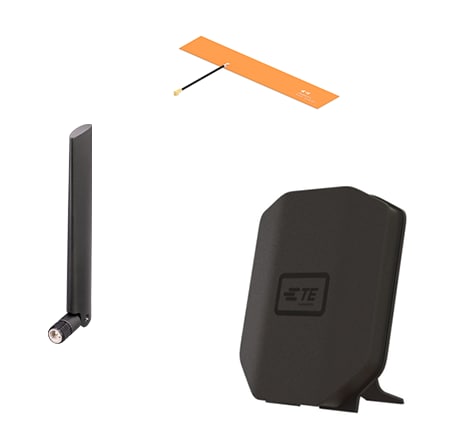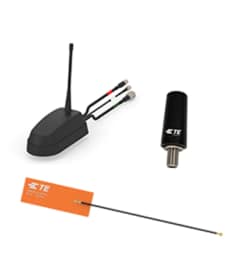Leveraging decades of experience designing for complex applications, our comprehensive antenna portfolio provides advanced solutions accommodating a broad range of frequency bands for operation on many networks across global and regional markets. Learn how our standard and custom antenna solutions enables the Internet of Things (IoT).

Cellular Antenna: Engineered for robust mobile connectivity
Our cellular antennas are designed to operate on licensed or unlicensed cellular frequencies. Typically, cellular antennas are sub-6GHz but these can range from 617-7125 MHz for many unlicensed applications. Our cellular antennas are available in many shapes, sizes, and formats, from embedded board mount antennas measuring 3mm in length to external cellular antennas measuring over 3 meters. Cellular antennas are often required when the availability of quality of hard-wired connectivity is not present, such as copper cabling. Cellular antennas provide an alternative to Wi-Fi in locations where installing the cabled infrastructure is prohibitive or not possible.
The size, shape, and antenna type required greatly depends on the application it will be used for. IoT (Internet of Things) devices, for example, often require an antenna that is capable of mounting inside a small or space-constrained device and operate effectively near other hardware or electrical components. For coverage over long distances or for significantly increased gain, the antenna itself must become much larger. Omnidirectional Base Station antennas, for example, can be 3m in length/height.
To make a high gain antenna more compact, it must change format. For example, Yagi or Log Periodic antennas are significantly smaller than a large base station antenna, but they can offer high gain for coverage over long distances. They achieve this by including many more antenna elements within a more compact format, making the radiation pattern of the antenna highly directional.
There are also advantages in using cellular antennas indoors. Higher frequency cellular, such as 5G, is less able to penetrate from outside to inside a building. To provide seamless connectivity inside the building or campus area, cellular antennas in multiple formats can be installed within the building. This allows for seamless 4G or 5G operations within the building.
Licensed cellular bands allow operators to create private networks. This means that a small portion of a cellular frequency can be purchased or licensed by an operator and is not open to general users. Common examples are the 900 MHz and CBRS/C-band frequency bands that are available to be licensed for more private and therefore secure communications networks.
The mounting location and application of the antenna are highly significant in the antenna options available. TE has the largest portfolio of antennas available as well as custom development and LDS antenna technology on hand. If the antenna is not available in our portfolio, we can create a custom product designed specifically for a customer or application.
5G
The high-speed transmission, low latency and large-scale data communication of 5G can support massive consumer applications to achieve real-time and high reliability.
IoT
Cellular is the most common service used for the internet of things which is the network of physical devices, vehicles, home appliances and others. IoT and the Cellular service enables these things to connect and exchange data.
M2M
Machine to machine communication can include industrial instrumentation, enabling a sensor or meter to communicate the data it records to application software that can use it.
Product Highlight: Ultra-Wide Band (UWB) Antennas
TE Connectivity's (TE) adhesive mount ultra-wide band (UWB) antennas offer an independent ultra-thin ground plane alternative to ceramic chip antennas, increasing the design flexibility by mounting the antenna to the enclosure of your device. These devices can enable precise indoor positioning and tracking applications, access control, and contact tracing. With the ability to locate objects to/within 10cm and mount to the enclosure of your device, UWB antennas provide a powerful solution in a small package for low and high band UWB channels 1 to 9 (3-8.5 GHz).
Lockers to phones, electric vehicles to chargers, hearts to doctors—IoT connects anything to everything. TE is expanding that connection on a global scale with stronger, more reliable connectivity solutions. Together, let’s drive towards a more connected future of everything.
Technology continues to get smaller and smarter. As more devices join networks, you’ll need the support to progress your Wi-Fi to the next stage of evolution: Wi-Fi 7. TE is your behind-the-scenes partner with decades of manufacturing experience, constantly advancing custom-designed and standard antennas that enable every new phase in wireless connectivity. Together, we can engineer new possibilities for the future of Wi-Fi connection.

Antennas for 5G, NB-IoT and Cat-M
TE develops antennas for 5G, NB-IoT and Cat-M, addressing the wide frequency band and various bandwidth demands from cellular Internet of Things (IoT) devices. They are able to provide a variety of band solutions ranging from 600 MHz to 7.125 GHz. Depending on their system architecture, customers can choose these antennas with different mounting types (e.g. board mount, embedded, external or terminal antenna), cable length and connector options. These antennas can be easily integrated to end devices since no tuning is needed and TE can offer service for embedding and even complex multiple antennas assemblies.
Automotive & Commercial Vehicle Applications
TE develops a wide range of antennas for vehicle, public transport and emergency services applications.
The antennas are often used for aftermarket or fleet and other mobile applications. TE's antennas range for single port and single band solutions to multi-port and multi-band antennas. The multi-port antennas, or combination antennas as they are sometimes known, generally offer 4G, 5G LTE, Wi-Fi, and GNSS from a single antenna. Some antennas also offer bluetooth and VHF, UHF and public safety frequencies from a single antenna.
For use in vehicles, we offer variable designs for different interior, covert and exterior installations.
Communication Equipment & Consumer Devices
TE offers a broad selection of standard antennas and an impressive capability for custom antenna solutions; we work closely with customers to achieve successful integration solutions. Our LDS antennas and MetaSpan technology can save valuable space in your application by integrating high frequency, mechanical and electrical functionality into one component. Whether you work on communications equipment or consumer devices, IoT or machine-to-machine (M2M) applications, or applications in the connected home space – our antenna specialists can work with you to develop the right antenna solution for your design.





